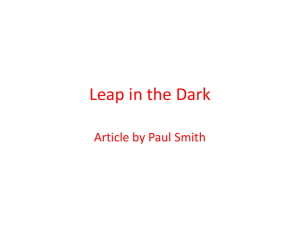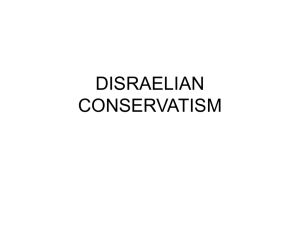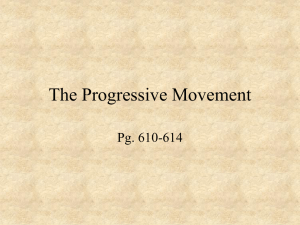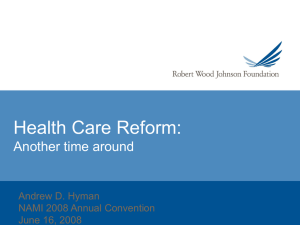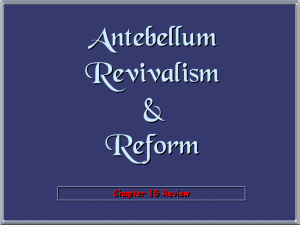1867 Reform Act (NG)
advertisement
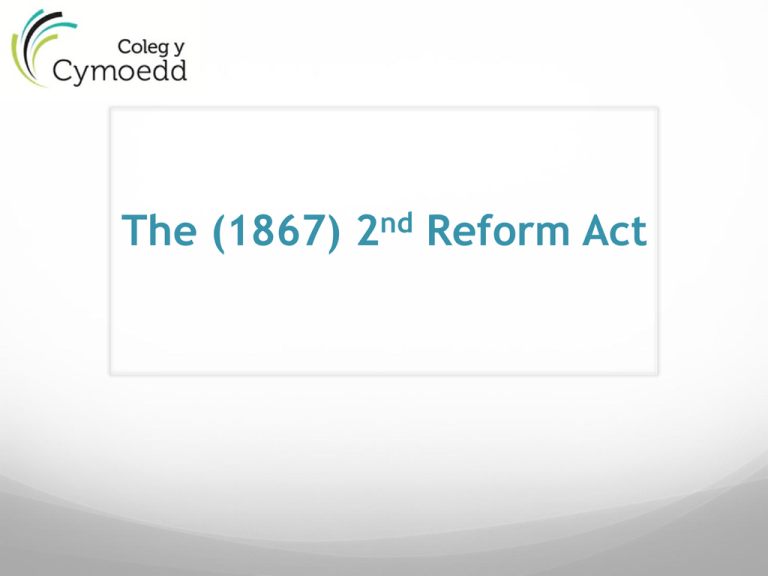
The (1867) 2nd Reform Act The Second Reform Act (1867) ‘A Leap in the Dark’ Factors promoting reform revival Extra / parliamentary radicals demand Reform Union & Reform League Middle and working class dissatisfaction with 1832 Population growth (1831 = 24m > 1861 = 29m) Industrial, urban expansion Respectable, deserving working class - US civil war Death of Palmerston – Shift in Liberal Party Doctrine Extra Parliamentary Pressure Reform Union Established by (MP) Birmingham John Reform League Bright Established 1865 Working Class Movement Middle class movement Sought landed W/C allies Supported by NMU’s against Aims for household franchise Seeks universal male suffrage but registered/residential Keep out unskilled – Residuum Redistribution to urban seats League and Union cooperate for limited reform Pressure brought on government The Liberal Party 1850’s - Liberal Party dominance under Palmerston Reform Bills all rejected By 1864 Gladstone was converted to reform 1865, Palmerston’s death – arch anti reformer Replaced by Lord John Russell Whigs Peelites Radicals Liberals Represented the majority of the country’s views 1866 Reform Bill Gladstone authored the 1866 Reform Bill Franchise extended to; Created 400,000 new voters Householder Lodger County £14 per year Borough £7 per year £10 per year X Catered to creating Whig support & limiting rural W/C Voters No. of Male voters increased from 1:5 to 1:4 Defeated by the Adullamites in league with Disraeli Russell resigns The Queen invites Lord Derby to form a government Disraeli becomes HoC Leader & Chancellor of the Exchequer 1867 Reform Act Lord Derby and Disraeli in Commons form minority Tories out of power since 1846 – Desperate for a win Introduce reform bill (March 1867) Created 1.2M new voters Householder Lodger Borough 1 year residence £10 per year County £12 per year £5 per year 45 Borough seats redistributed Disraeli enlisted the support of pro-reform Liberals There was growing discontent that needed addressing Reform League (Hyde Park Riots) The ‘Leap in the Dark’ Social Unrest Rejection of Gladstone / Russell Bill (June 1866) July: Demonstrations, riots Hyde Park and Trafalgar Square X3 nights Only League able to restore order Tense situation compounded by: Cholera epidemic Expensive bread Downturn in trade Sheffield outrages (1866) Loss of union fund protection Social Unrest 2nd Reform Act introduced: February 1867 May: Reform League rally, Hyde Park Government ban on rally. 100,000 strong rally proceeds Government’s fear: return to Chartist mass platform Pass bill to calm situation Enfranchise respectable working class Repeat of 1832: take away top layer ‘The Hyde Park Railway to Reform’ Party struggle Tories in minority since 1846 Reform inevitable and accepted Pass reform; Gain popularity Control reform Control seat redistribution Secure the County vote Amendments rejected: Votes for women Election expenses from rates: Shows fear of new (Labour) party development Verdict on 1867 Disraeli’s shrewd political footwork. ‘Dishing the Whigs’ Gains Tory advantage, Quells agitation and riots Wider effects of 1867: Age of mass politics: growth of party organisation 1 in 3: England, Scotland and Wales 1 in 6 in Ireland Mass electorate: difficult to bribe, intimidate Prompts further parliamentary reform; 1872 Ballot Act & 1883 Corrupt Practices Act (Gladstone)


